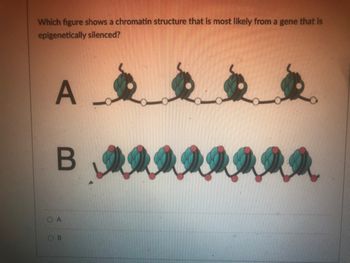
Human Anatomy & Physiology (11th Edition)
11th Edition
ISBN: 9780134580999
Author: Elaine N. Marieb, Katja N. Hoehn
Publisher: PEARSON
expand_more
expand_more
format_list_bulleted
Question

Transcribed Image Text:Which figure shows a chromatin structure that is most likely from a gene that is
epigenetically silenced?
A
B
OA
B
Expert Solution
This question has been solved!
Explore an expertly crafted, step-by-step solution for a thorough understanding of key concepts.
Step by stepSolved in 3 steps

Knowledge Booster
Learn more about
Need a deep-dive on the concept behind this application? Look no further. Learn more about this topic, biology and related others by exploring similar questions and additional content below.Similar questions
- Explain why a heteroduplex region may be produced after branch migration occurs.arrow_forwardThe diagram shown represents the coding strand of the myosin gene. Mutations in myosin can lead to muscle defects during development. Using what you know about how mutations can affect transcriptional and post-transcriptional regulation, match the results shown on the Northern (mature mRNA) to the mutations shown. The N lane shows the size and amount expected for non-mutated myosin mRNA. All samples were loaded at the top (-) side of the gel. Part 1. Which lane or lanes on the gel could be the result of mutation A? --4 ТАТАА AUG UAA Only known regulatory region TSS Mutation B: Mutation C. A: 5-base 20 nucleotides 3 nucleotides deletion deleted changed N 1 2 3 4 5arrow_forwardIn eukaryotes, chromatin remodeling plays an important role is gene regulation. This is because a. repositioning of the nucleosomes makes DNA accessible to transcription regulatory proteins b. the nucleosomes contain important regulatory regions c. chromatin remodeling activates gene expression d. chromatin remodeling represses gene expressionarrow_forward
- Describe how methylation and acetylation of the histones changes gene expression in eukaryotes. What groups are added? How do these processes physically affect chromatin structure? Silencing or Enhancing expression?arrow_forwardIf an organism's cells were to not want a specific sequence of DNA transcribed for a long period of time, which of the following processes below would most likely allow for this to happen? O DNA acetylation O DNA methylation O histone methylation O histone acetylationarrow_forwardThe diagram shown represents the coding strand of the myosin gene. Mutations in myosin can lead to muscle defects during development. Using what you know about how mutations can affect transcriptional and post-transcriptional regulation, match the results shown on the Northern (mature mRNA) to the mutations shown. The N lane shows the size and amount expected for non-mutated myosin mRNA. All samples were loaded at the top (-) side of the gel. Part 1. Which lane or lanes on the gel could be the result of mutation A? ТАТА AUG UAA Only known regulatory region TSS Mutation B: Mutation C. 3 nucleotides 20 nucleotides deleted A: 5-base deletion changed 1 2 4 5 lane 1 lane 2 lane 3 lane 4 lane 5 OOO0Oarrow_forward
- Which of the following mutations in the protein-coding region of a gene is more likely to lead to complete loss of function of the encoded protein: an insertion of six nucleotides or a deletion of two nucleotides? Briefly explain your answer.arrow_forwardIn skin cells, a gene is never transcribed. Give two ways this could occur.arrow_forwardHow would each of the following types of mutations affect proteinfunction or the amount of functional protein that is expressed froma gene?A. Nonsense mutationB. Missense mutationC. Up promoter mutationD. Mutation that affects splicingarrow_forward
arrow_back_ios
arrow_forward_ios
Recommended textbooks for you
 Human Anatomy & Physiology (11th Edition)BiologyISBN:9780134580999Author:Elaine N. Marieb, Katja N. HoehnPublisher:PEARSON
Human Anatomy & Physiology (11th Edition)BiologyISBN:9780134580999Author:Elaine N. Marieb, Katja N. HoehnPublisher:PEARSON Biology 2eBiologyISBN:9781947172517Author:Matthew Douglas, Jung Choi, Mary Ann ClarkPublisher:OpenStax
Biology 2eBiologyISBN:9781947172517Author:Matthew Douglas, Jung Choi, Mary Ann ClarkPublisher:OpenStax Anatomy & PhysiologyBiologyISBN:9781259398629Author:McKinley, Michael P., O'loughlin, Valerie Dean, Bidle, Theresa StouterPublisher:Mcgraw Hill Education,
Anatomy & PhysiologyBiologyISBN:9781259398629Author:McKinley, Michael P., O'loughlin, Valerie Dean, Bidle, Theresa StouterPublisher:Mcgraw Hill Education, Molecular Biology of the Cell (Sixth Edition)BiologyISBN:9780815344322Author:Bruce Alberts, Alexander D. Johnson, Julian Lewis, David Morgan, Martin Raff, Keith Roberts, Peter WalterPublisher:W. W. Norton & Company
Molecular Biology of the Cell (Sixth Edition)BiologyISBN:9780815344322Author:Bruce Alberts, Alexander D. Johnson, Julian Lewis, David Morgan, Martin Raff, Keith Roberts, Peter WalterPublisher:W. W. Norton & Company Laboratory Manual For Human Anatomy & PhysiologyBiologyISBN:9781260159363Author:Martin, Terry R., Prentice-craver, CynthiaPublisher:McGraw-Hill Publishing Co.
Laboratory Manual For Human Anatomy & PhysiologyBiologyISBN:9781260159363Author:Martin, Terry R., Prentice-craver, CynthiaPublisher:McGraw-Hill Publishing Co. Inquiry Into Life (16th Edition)BiologyISBN:9781260231700Author:Sylvia S. Mader, Michael WindelspechtPublisher:McGraw Hill Education
Inquiry Into Life (16th Edition)BiologyISBN:9781260231700Author:Sylvia S. Mader, Michael WindelspechtPublisher:McGraw Hill Education

Human Anatomy & Physiology (11th Edition)
Biology
ISBN:9780134580999
Author:Elaine N. Marieb, Katja N. Hoehn
Publisher:PEARSON

Biology 2e
Biology
ISBN:9781947172517
Author:Matthew Douglas, Jung Choi, Mary Ann Clark
Publisher:OpenStax

Anatomy & Physiology
Biology
ISBN:9781259398629
Author:McKinley, Michael P., O'loughlin, Valerie Dean, Bidle, Theresa Stouter
Publisher:Mcgraw Hill Education,

Molecular Biology of the Cell (Sixth Edition)
Biology
ISBN:9780815344322
Author:Bruce Alberts, Alexander D. Johnson, Julian Lewis, David Morgan, Martin Raff, Keith Roberts, Peter Walter
Publisher:W. W. Norton & Company

Laboratory Manual For Human Anatomy & Physiology
Biology
ISBN:9781260159363
Author:Martin, Terry R., Prentice-craver, Cynthia
Publisher:McGraw-Hill Publishing Co.

Inquiry Into Life (16th Edition)
Biology
ISBN:9781260231700
Author:Sylvia S. Mader, Michael Windelspecht
Publisher:McGraw Hill Education